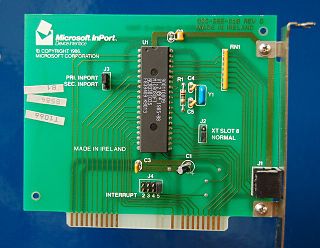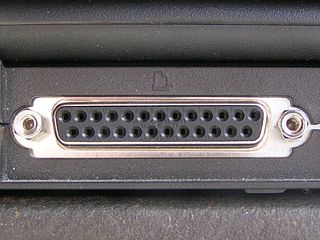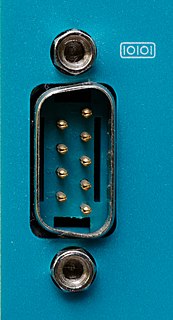 W
WAMX Mouse was a 1985 computer mouse sold by the British company Advanced Memory Systems. The 3 button mouse was sold with a dedicated interface, and usually with some accompanying software such as AMX Art, AMX Pagemaker, AMX Palette, AMX Control and Icon Designer.
 W
WThe Atari joystick port is a computer port used to connect various gaming controllers to game console and home computer systems in the 1970s to the 1990s. It was originally introduced on the Atari 2600 in 1977 and then used on the Atari 400 and 800 in 1979. It went cross-platform with the Commodore VIC-20 of 1981, and was then used on many following machines from both companies, as well as a growing list of 3rd party machines like the MSX platform and various Sega consoles.
 W
WA BBC Micro expansion unit, for the BBC Micro is one of a number of peripherals in a box with the same profile and styling as the main computer.
 W
WA bus mouse is a variety of PC computer mouse which is attached to the computer using a specialized interface.
 W
WThe Commodore serial IEEE-488 bus, is Commodore's interface for primarily magnetic disk data storage and printers for the Commodore 8-bit home/personal computers, notably the VIC-20, C64, C128, Plus/4, C16 and C65.
 W
WA floppy disk or floppy diskette is a type of disk storage composed of a thin and flexible disk of a magnetic storage medium in a square or nearly square plastic enclosure lined with a fabric that removes dust particles from the spinning disk. Floppy disks store digital data which can be read and written when the disk is inserted into a floppy disk drive (FDD) connected to or inside a computer or other device.
 W
WA floppy disk hardware emulator or semi-virtual diskette (SVD) is a device that emulates a floppy disk drive with a solid state or network storage device that is plug compatible with the drive it replaces, similar to how solid-state drives replace mechanical hard disk drives.
 W
WThe floppy disk is a data storage and transfer medium that was ubiquitous from the mid-1970s well into the 2000s. Besides the 3½-inch and 5¼-inch formats used in IBM PC compatible systems, or the 8-inch format that preceded them, many proprietary floppy disk formats were developed, either using a different disk design or special layout and encoding methods for the data held on the disk.
 W
WThe game port, originally introduced on the Game Control Adapter, is a device port that was found on IBM PC compatible and other computer systems throughout the 1980s and 1990s. It was the traditional connector for joystick input, and occasionally MIDI devices, until obsoleted by USB in the late 1990s.
 W
WHardcard is the genericized trademark for a hard disk drive, disk controller, and host adapter on an expansion card for a personal computer.
 W
WA floppy disk is a disk storage medium composed of a disk of thin and flexible magnetic storage medium encased in a rectangular plastic carrier. It is read and written using a floppy disk drive (FDD). Floppy disks were an almost universal data format from the 1970s into the 1990s, used for primary data storage as well as for backup and data transfers between computers.
 W
WIEEE 1284 is a standard that defines bi-directional parallel communications between computers and other devices. It was originally developed in the 1970s by Centronics, and was widely known as the Centronics port, both before and after its IEEE standardization.
 W
WIndustry Standard Architecture (ISA) is the 16-bit internal bus of IBM PC/AT and similar computers based on the Intel 80286 and its immediate successors during the 1980s. The bus was (largely) backward compatible with the 8-bit bus of the 8088-based IBM PC, including the IBM PC/XT as well as IBM PC compatibles.
 W
WIn computing, a legacy port is a computer port or connector that is considered by some to be fully or partially superseded. The replacement ports usually provide most of the functionality of the legacy ports with higher speeds, more compact design, or plug and play and hot swap capabilities for greater ease of use. Modern PC motherboards use separate Super I/O controllers to provide legacy ports, since current chipsets do not offer direct support for them. A category of computers called legacy-free PCs omits these ports, typically retaining only USB for external expansion.
 W
WThis is a list of different floppy disk formats.
 W
WLocalTalk is a particular implementation of the physical layer of the AppleTalk networking system from Apple Computer.
 W
WA magneto-optical drive is a kind of optical disc drive capable of writing and rewriting data upon a magneto-optical disc. Both 130 mm (5.25 in) and 90 mm (3.5 in) form factors exist. In 1983, just a year after the introduction of the Compact Disc, Kees Schouhamer Immink and Joseph Braat presented the first experiments with erasable magneto-optical Compact Discs during the 73rd AES Convention in Eindhoven. The technology was introduced commercially in 1985. Although optical, they normally appear as hard disk drives to an operating system and can be formatted with any file system. Magneto-optical drives were common in some countries, such as Japan, but have fallen into disuse.
 W
WIn computing, a parallel port is a type of interface found on early computers for connecting peripherals. The name refers to the way the data is sent; parallel ports send multiple bits of data at once, as opposed to serial communication, in which bits are sent one at a time. To do this, parallel ports require multiple data lines in their cables and port connectors and tend to be larger than contemporary serial ports, which only require one data line.
 W
WA PC speaker is a loudspeaker built into some IBM PC compatible computers. The first IBM Personal Computer, model 5150, employed a standard 2.25 inch magnetic driven (dynamic) speaker. More recent computers use a tiny moving-iron or piezo speaker instead. The speaker allows software and firmware to provide auditory feedback to a user, such as to report a hardware fault. A PC speaker generates waveforms using the programmable interval timer, an Intel 8253 or 8254 chip. In German, it is referred to as "system speaker".
 W
WA punched card is a piece of stiff paper that holds digital data represented by the presence or absence of holes in predefined positions. Punched cards were once common in data processing applications or to directly control automated machinery.
 W
WIn computing, a serial port is a serial communication interface through which information transfers in or out sequentially one bit at a time. This is in contrast to a parallel port, which communicates multiple bits simultaneously in parallel. Throughout most of the history of personal computers, data has been transferred through serial ports to devices such as modems, terminals, various peripherals, and directly between computers.
 W
WIn computing, a legacy system is an old method, technology, computer system, or application program, "of, relating to, or being a previous or outdated computer system," yet still in use. Often referencing a system as "legacy" means that it paved the way for the standards that would follow it. This can also imply that the system is out of date or in need of replacement.
 W
WA USB adapter is a type of protocol converter that is used for converting USB data signals to and from other communications standards. Commonly, USB adapters are used to convert USB data to standard serial port data and vice versa. Most commonly the USB data signals are converted to either RS232, RS485, RS422, or TTL-level UART serial data. The older serial RS423 protocol is rarely used any more, so USB to RS423 adapters are less common.